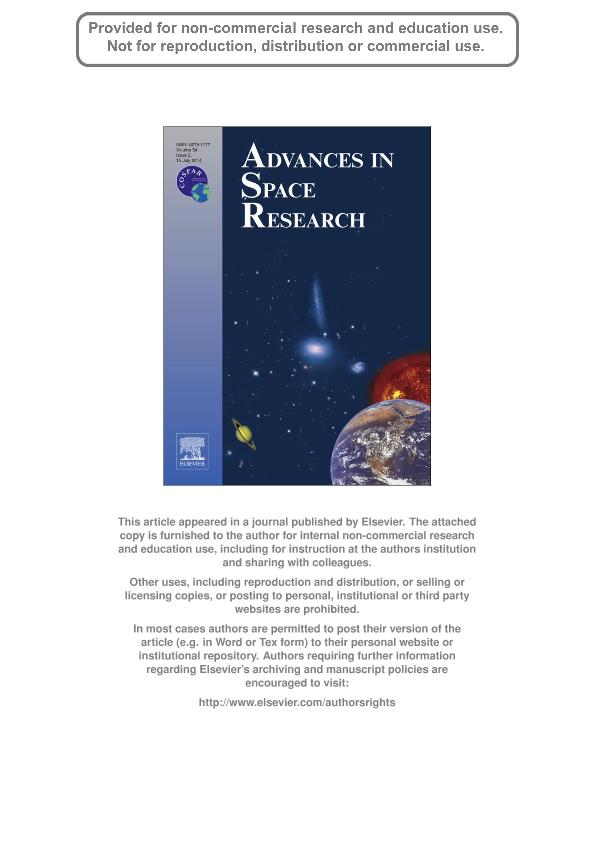Mostrar el registro sencillo del ítem
dc.contributor.author
Fernandez, Laura Isabel

dc.contributor.author
Meza, Amalia Margarita

dc.contributor.author
Elias, Ana Georgina

dc.date.available
2017-12-19T21:21:44Z
dc.date.issued
2014-07
dc.identifier.citation
Elias, Ana Georgina; Meza, Amalia Margarita; Fernandez, Laura Isabel; Quasi-biennial oscillation in GPS VTEC measurements; Elsevier; Advances in Space Research; 54; 2; 7-2014; 161-167
dc.identifier.issn
0273-1177
dc.identifier.uri
http://hdl.handle.net/11336/31072
dc.description.abstract
The quasi-biennial oscillation, QBO, a well known periodicity in the equatorial stratospheric zonal winds, is also found in ionospheric parameters and in solar and geomagnetic activity indices. Many authors speculated about the link between the QBO in solar and geomagnetic activity and the QBO in atmospheric parameters. In this work we analyze the presence of the QBO in the ionosphere using the Vertical Total Electron Content (VTEC) values obtained from Global Navigation Satellite System (GNSS) measurements during the period 1999?2012. In particular, we used IONEX files, i.e. the International GNSS Service (IGS) ionospheric products. IONEX provide VTEC values around the world at 2-h intervals. From these data we compute global and zonal averages of VTEC at different local times at mid and equatorial geomagnetic latitudes. VTEC and Extreme Ultra Violet (EUV) solar flux time series are analyzed using a wavelet multi resolution analysis. In all cases the QBO is detected among other expected periodicities. Since the main source of variation of free electrons in the ionospheric F2 region, where the maximum concentration occurs, is solar EUV radiation, we conclude that the most important cause attributable to QBO in the ionosphere is the quasi-biennial variability of EUV solar flux. Both QBOs are observed to vary in phase. The percentage of the total signal of the ionospheric QBO at the local times of the maximum photoionization is around 15% independent of magnetic latitude while the respective percentage of the total energy for the EUV solar flux is about 18%.
dc.format
application/pdf
dc.language.iso
eng
dc.publisher
Elsevier

dc.rights
info:eu-repo/semantics/openAccess
dc.rights.uri
https://creativecommons.org/licenses/by-nc-sa/2.5/ar/
dc.subject
Quasi Biennial Oscillation
dc.subject
Wavelet
dc.subject
Global Igs Vtec Maps
dc.subject.classification
Meteorología y Ciencias Atmosféricas

dc.subject.classification
Ciencias de la Tierra y relacionadas con el Medio Ambiente

dc.subject.classification
CIENCIAS NATURALES Y EXACTAS

dc.title
Quasi-biennial oscillation in GPS VTEC measurements
dc.type
info:eu-repo/semantics/article
dc.type
info:ar-repo/semantics/artículo
dc.type
info:eu-repo/semantics/publishedVersion
dc.date.updated
2017-12-11T19:32:45Z
dc.journal.volume
54
dc.journal.number
2
dc.journal.pagination
161-167
dc.journal.pais
Países Bajos

dc.journal.ciudad
Amsterdam
dc.description.fil
Fil: Fernandez, Laura Isabel. Universidad Nacional de la Plata. Facultad de Ciencias Astronómicas y Geofísicas; Argentina. Consejo Nacional de Investigaciones Científicas y Técnicas; Argentina
dc.description.fil
Fil: Meza, Amalia Margarita. Consejo Nacional de Investigaciones Científicas y Técnicas; Argentina. Universidad Nacional de la Plata. Facultad de Ciencias Astronómicas y Geofísicas; Argentina
dc.description.fil
Fil: Elias, Ana Georgina. Consejo Nacional de Investigaciones Científicas y Técnicas; Argentina. Universidad Nacional de Tucumán. Facultad de Ciencias Exactas y Tecnologia; Argentina
dc.journal.title
Advances in Space Research

dc.relation.alternativeid
info:eu-repo/semantics/altIdentifier/doi/http://dx.doi.org/10.1016/j.asr.2014.03.027
dc.relation.alternativeid
info:eu-repo/semantics/altIdentifier/url/http://www.sciencedirect.com/science/article/pii/S027311771400204X
Archivos asociados
